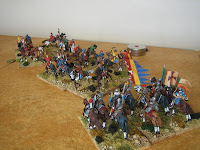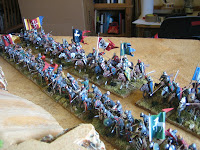
The first part of this scenario lays out the strategic situation leading to the Battle of Bicocca, the dispositions, the orders of battle and the terrain. The second will detail the scenario specific rules, what ifs, and umpire notes.
Strategic Situation
In the summer of 1521 the French were sitting pretty. Their possession of the Milanese was secure, their alliance with the Venetians was preventing Landsknechts from the north joining the Spanish forces of Naples, and the Emperor Charles was tied down fighting two disastrous ‘civil wars’ in Spain and the Low Countries.
Then late in 1521 a large body of Landsknechts managed, by making forced marches across a narrow strip of Venetian territory, to slip into Italy. These troops shifted the balance of power. In November the French, who had gone into winter quarters too early, were forced out of Milan. Later Alessandria, Pavia, and Como also fell into Imperial hands.
The loss of the greater part of the Milanese was more than King Francis I could stand. He immediately ordered the raising of a new army for its recovery. The new army, under the command of Lautrec the Viceroy of Milan, was one of the largest raised by France during the Italian Wars. It was much larger than the force in opposition, commanded by the old condottieri captain Prosper Colonna, and this gave rise to the manner of the campaign that followed.
The French first moved to besiege Pavia, hoping that an attempt on such an important place might force Colonna into the field and offer battle. Prosper Colonna did come out – as far as the monastery of Certosa (10 miles from Milan) on the Pavia Milan road. Lautrec sent out scouts to reconnoitre his position but they reported that the position Colonna had taken up was all but impregnable. Lautrec, cautious by nature, was unwilling to attack. He instead decided to move north and cut off Colonna’s lines of communication with Milan in the hope that he would move. Colonna withdrew to the Park of Bicocca, 4 miles from Milan, and established himself in another naturally strong position which he then fortified with earthworks.


Then late in 1521 a large body of Landsknechts managed, by making forced marches across a narrow strip of Venetian territory, to slip into Italy. These troops shifted the balance of power. In November the French, who had gone into winter quarters too early, were forced out of Milan. Later Alessandria, Pavia, and Como also fell into Imperial hands.
The loss of the greater part of the Milanese was more than King Francis I could stand. He immediately ordered the raising of a new army for its recovery. The new army, under the command of Lautrec the Viceroy of Milan, was one of the largest raised by France during the Italian Wars. It was much larger than the force in opposition, commanded by the old condottieri captain Prosper Colonna, and this gave rise to the manner of the campaign that followed.
The French first moved to besiege Pavia, hoping that an attempt on such an important place might force Colonna into the field and offer battle. Prosper Colonna did come out – as far as the monastery of Certosa (10 miles from Milan) on the Pavia Milan road. Lautrec sent out scouts to reconnoitre his position but they reported that the position Colonna had taken up was all but impregnable. Lautrec, cautious by nature, was unwilling to attack. He instead decided to move north and cut off Colonna’s lines of communication with Milan in the hope that he would move. Colonna withdrew to the Park of Bicocca, 4 miles from Milan, and established himself in another naturally strong position which he then fortified with earthworks.


Naturally, Lautrec was willing to play the long game. Eventually, by manoeuvre, he would force Colonna into a less favourable position. But then Lautrec found himself facing a problem he did not expect. His Swiss mercenaries, the back bone of his army, went on strike for lack of pay. The Swiss wanted a quick campaign and prompt payment, and the surest way of getting it was to beat Colonna in the field and reap the benefit of the cities and towns that would surely fall without resistance afterwards. If Lautrec did not attack the next day, they would, to a man, march back to the Alps. However, to show good faith, the Swiss volunteered to take position at the sharp point of any attack. Lautrec reluctantly agreed.




The scene was set for one of the bloodiest affairs of The Great Italian Wars: A frontal attack against a naturally strong and heavily fortified position. The deployment map below shows the dispositions of the forces involved.

The Field
Colonna had positioned himself at the Park of Bicocca; gardens and fields surrounding a manor house four miles outside Milan. The ground, as with all the ground around Milan, was dead flat and cut up with drainage ditches; the ditches around the park being particularly deep and wet. The land immediately to the west of Colonna’s position was especially boggy and unfit for the movements of troops. Directly in front of his position was a sunken road. Colonna had ordered that the hollow should be deepened and the earth piled into an earth rampart at its rim. At various points along the sunken road, Colonna’s engineers had sited raised platforms on which to place his artillery. By the time they had finished, an almost shear earth wall, 18 foot high had been constructed. The only immediate way into the park was via a narrow bridge, off the Milan road, and to Colonna’s rear.
Colonna had positioned himself at the Park of Bicocca; gardens and fields surrounding a manor house four miles outside Milan. The ground, as with all the ground around Milan, was dead flat and cut up with drainage ditches; the ditches around the park being particularly deep and wet. The land immediately to the west of Colonna’s position was especially boggy and unfit for the movements of troops. Directly in front of his position was a sunken road. Colonna had ordered that the hollow should be deepened and the earth piled into an earth rampart at its rim. At various points along the sunken road, Colonna’s engineers had sited raised platforms on which to place his artillery. By the time they had finished, an almost shear earth wall, 18 foot high had been constructed. The only immediate way into the park was via a narrow bridge, off the Milan road, and to Colonna’s rear.
Orders of Battle:
For this game I will be using a figure ratio of 1 to 50. Although the overall figures are accurate, I have had to make an educated guess as to the composition of each contingent. I have taken the liberty of calling all the heavy cavalry Gendarmes – so that there is no misunderstanding of their arms. I have also had to make some small compromises because of my 'stand / basing' sizes.
For this game I will be using a figure ratio of 1 to 50. Although the overall figures are accurate, I have had to make an educated guess as to the composition of each contingent. I have taken the liberty of calling all the heavy cavalry Gendarmes – so that there is no misunderstanding of their arms. I have also had to make some small compromises because of my 'stand / basing' sizes.






Lautrec and the French:
1000 Gendarmes: In three units of 7. Those on the left are commanded by Lautrec and Lescun. Those on the right could be under the command of Bayard.
6000 French Foot: One unit of 72 pike, four units of 10 - 12 crossbows. I have given command of the foot to Marshal de Foix.
8000 Swiss: Two units of 72 pike, two units of 10 - 12 arquebus. The left hand column is commanded by Von Stein, the right by Winkelried.
6000 Venetian foot: One unit of 72 pike, four units of 10 - 12 arquebus. They fall under the command of Urbino (see below).
400 Venetian Gendarmes: One unit of 7. They are under the command of the Duke of Urbino.
3300 Giovanni dei Medici’s Black Bands: Six units of 10 - 12 arquebus, one unit of 6 mounted arquebus.
French Artillery: An unknown number of guns represented by two batteries of 2 guns each.




Colonna and the Imperialists:
200 Spanish Gendarmes: Generously, one unit of 7. Commanded by Colonna.
2000 Spanish arquebus: In four units of ten to twelve.
2000 Spanish pike: In one unit of 36 pike and 9 sword and buckler. I have put these under the command De Leyva.
1000 Spanish Genitors: In three units of 6.
8000 Landsknechts: two units of 72 pike. One column is commanded by Von Frundsberg.
Spanish artillery: an unknown number of guns represented by two batteries of 2 guns.
2000 Milanese foot: The vanguard of the 6000 Milanese Militia called to arms on the previous day. Four units of 10 – 12 crossbow.
400 Milanese Gendarmes: One unit of 7. Commanded by Sforza, the newly re-established Duke of Milan.
1000 Gendarmes: In three units of 7. Those on the left are commanded by Lautrec and Lescun. Those on the right could be under the command of Bayard.
6000 French Foot: One unit of 72 pike, four units of 10 - 12 crossbows. I have given command of the foot to Marshal de Foix.
8000 Swiss: Two units of 72 pike, two units of 10 - 12 arquebus. The left hand column is commanded by Von Stein, the right by Winkelried.
6000 Venetian foot: One unit of 72 pike, four units of 10 - 12 arquebus. They fall under the command of Urbino (see below).
400 Venetian Gendarmes: One unit of 7. They are under the command of the Duke of Urbino.
3300 Giovanni dei Medici’s Black Bands: Six units of 10 - 12 arquebus, one unit of 6 mounted arquebus.
French Artillery: An unknown number of guns represented by two batteries of 2 guns each.




Colonna and the Imperialists:
200 Spanish Gendarmes: Generously, one unit of 7. Commanded by Colonna.
2000 Spanish arquebus: In four units of ten to twelve.
2000 Spanish pike: In one unit of 36 pike and 9 sword and buckler. I have put these under the command De Leyva.
1000 Spanish Genitors: In three units of 6.
8000 Landsknechts: two units of 72 pike. One column is commanded by Von Frundsberg.
Spanish artillery: an unknown number of guns represented by two batteries of 2 guns.
2000 Milanese foot: The vanguard of the 6000 Milanese Militia called to arms on the previous day. Four units of 10 – 12 crossbow.
400 Milanese Gendarmes: One unit of 7. Commanded by Sforza, the newly re-established Duke of Milan.







































